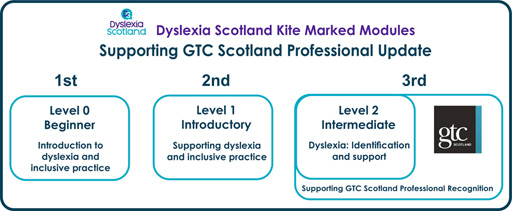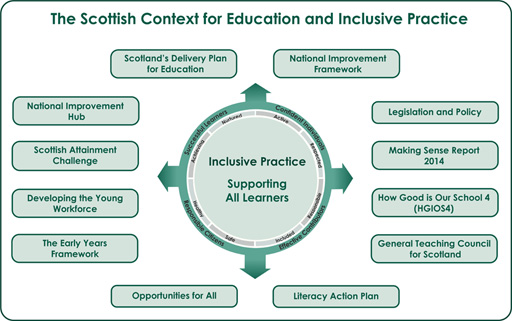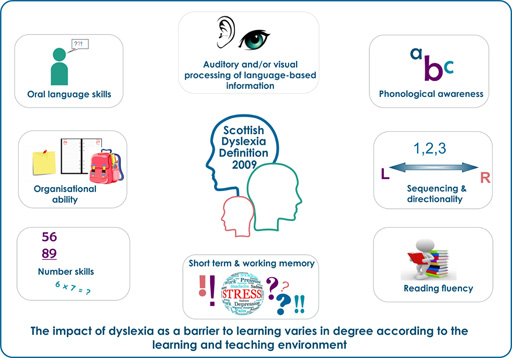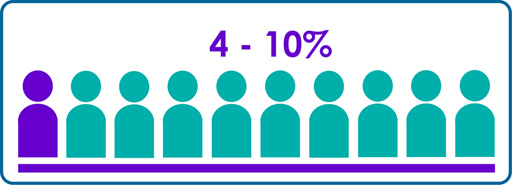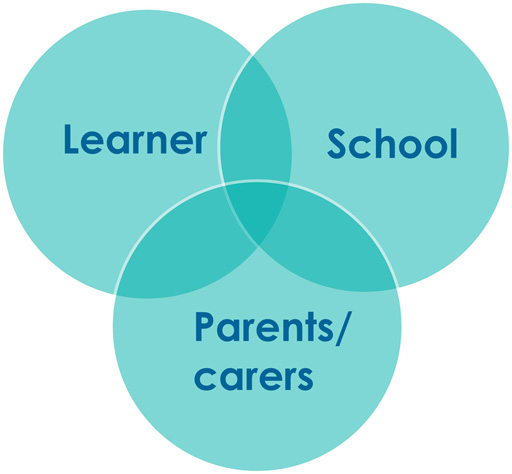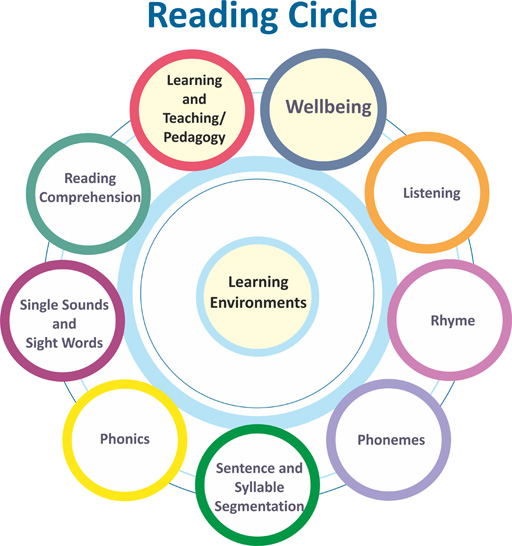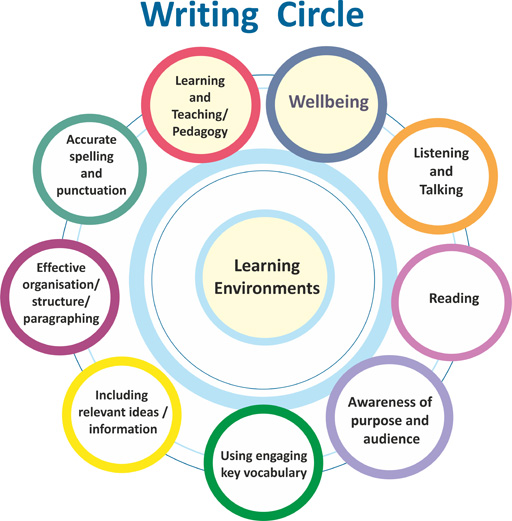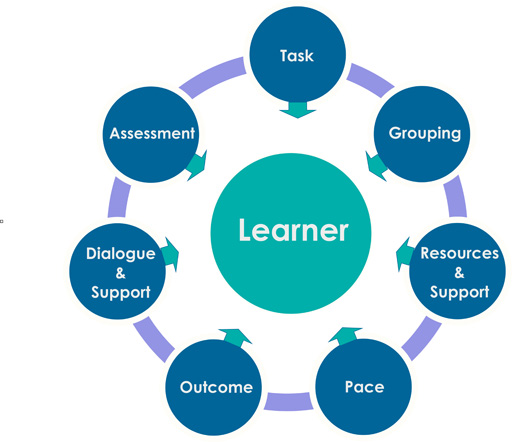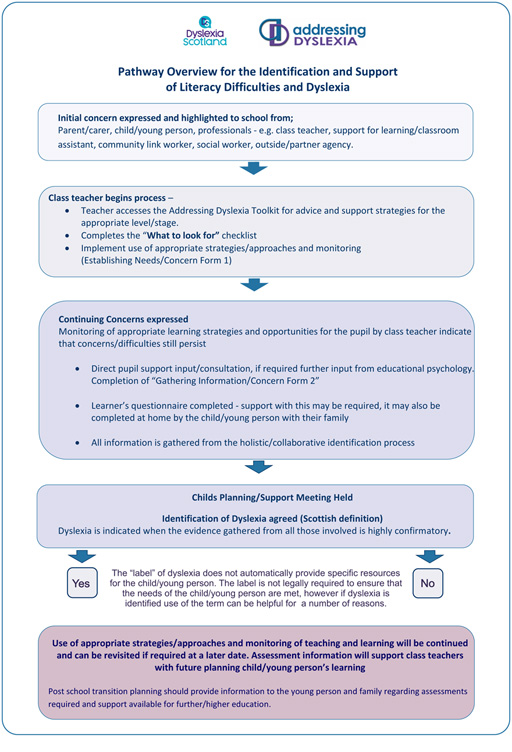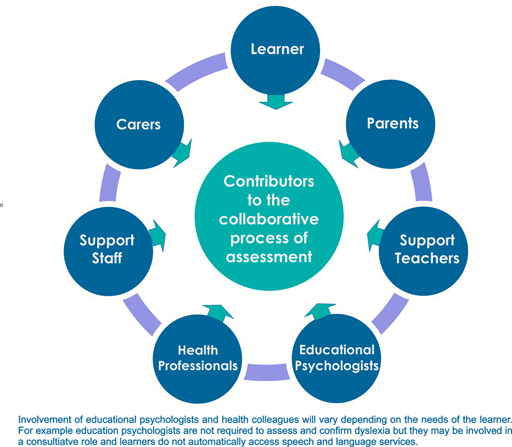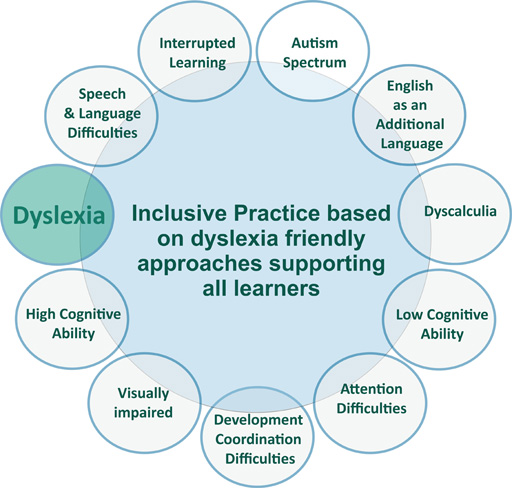Use 'Print preview' to check the number of pages and printer settings.
Print functionality varies between browsers.
Printable page generated Friday, 19 April 2024, 5:16 AM
An introduction to dyslexia and inclusive practice
Module overview
Welcome to this free module, An introduction to dyslexia and inclusive practice. It is designed to provide an introduction for teachers, community educators and anyone with an interest in developing positive approaches to supporting dyslexia in their inclusive practice. The module supports the recommendations of the 2014 Education Scotland Review: ‘Making Sense: Education for Children and Young People with Dyslexia in Scotland’. It is the first of three linked modules written by the Addressing Dyslexia Toolkit and Dyslexia Scotland with the support of the Opening Educational Practices in Scotland Project. All three modules use the General Teaching Council Scotland’s focus areas identified to support professional learning:
- Pedagogy, learning and subject knowledge
- Curriculum and assessment
- Enquiry and research
- Educational contexts and current debates in policy, education and practice
- Sustaining and developing professional learning
- Learning for sustainability
Further information on the General Teaching Council Scotland’s professional learning can be accessed online.
This first module provides you with a basic introduction to dyslexia and inclusive practice. It is split into seven sections, which you can access via the navigation panel on the left hand side of each page.
The module includes a reflective log, which can be used to support the General Teaching Council for Scotland’s requirement to maintain professional standards. The activities in the module can be completed on your own but you can also use them to support group work with colleagues.
During the module, you can test your knowledge by taking some practice quizzes. At the end of the module, you will be asked to complete an assessed quiz. If you gain a score of at least 60% in the assessed quiz, have attempted the practice quizzes and have clicked through all the pages of the module you will earn a digital badge.
Introduction
This introductory module aims to provide teachers and local authority staff with an awareness of what dyslexia is, its impact and how it can be supported within an inclusive school community. It may also be of interest if you work in the voluntary sector or simply have an interest in dyslexia and inclusive practice.
As a classroom teacher you do not have to know everything about dyslexia; however you do need to know where to go for information, guidance and support. Each section of the module uses the General Teaching Council for Scotland (GTCS) Professional Standards framework and provides opportunities to reflect on your own practice. This in turn will help support and direct your future professional development needs. Studying the module and logging your reflections can contribute towards your folio of evidence for the General Teaching Council for Scotland Professional update.
The Scottish Government working with partners have supported the development of free professional learning resources, some of which are highlighted below. These resources aim to provide teachers and local authority staff with an awareness of what dyslexia is, its impact and how it can be supported within an inclusive school community.
- The Addressing Dyslexia Toolkit – An online resource developed and funded by the Scottish Government. The toolkit is managed by Dyslexia Scotland to support teachers and provide information on dyslexia and literacy difficulties.
- Education Scotland − Route Map for Dyslexia and Inclusive Practice – To support deeper learning and understanding of dyslexia using the GTCS areas for career long professional learning (CLPL) and the four broad elements identified by Education Scotland. This route map supports teachers in reflective practice, inclusive practice and professional learning.
- This Introductory short online module in partnership with The Open University in Scotland, which follows the same structure as the route map above.
Learning outcomes
After studying this introductory module and participating in the tasks you will have an awareness of:
- The education context in Scotland and the national agenda
- What dyslexia is and its impact
- Dyslexia and inclusive practice
- Effective communication
- How dyslexia is identified
- Information and practical support strategies
How you can study this module
This module can be studied sequentially, or the material can be used as a reference guide with sections explored in any order. If studied as a module the core content should take around 3 hours to work through. Section 1 is the longest section and will take about half of the total study time.
You can study at your own pace. However, as you work through the module, think about not only your role but also that of other partners and colleagues you work with. You might find it helpful to form an informal study group with colleagues and use some of the activities as a basis for group discussion.
Teachers do not have to know everything about dyslexia; however they do need to know where to go for information, guidance and support.
We have also provided downloadable alternative formats of the course. You can find these on the first page of each section.
If you work through all of the content in this module, tackle the formative quizzes and pass the end-of-module quiz you will be awarded with a digital badge to recognise your learning.
Badge information
What is a badged course?
Badges are a means of digitally recognising certain skills and achievements acquired through informal study and are entirely optional. They do not carry any formal credit as they are not subject to the same rigour as formal assessment; nor are they proof that you have studied the full unit or course. They are a useful means of demonstrating participation and recognising informal learning.
If you'd like to learn more about badges, you will find more information on the following websites:
- Open Badges [Tip: hold Ctrl and click a link to open it in a new tab. (Hide tip)] – this information is provided by Mozilla, a leading provider of the open badges system.
- Digital Badges – this information is provided by HASTAC (Humanities, Arts, Science and Technology Alliance and Collaboratory), a global community working to transform how we learn, and particularly making use of technology.
Gaining your badge
To gain the digital badge for An introduction to dyslexia and inclusive practice , you will need to:
- Complete the short quizzes that you will find at the end of sections 1 and 5 of the module. These section quizzes are formative. They are really helpful in consolidating your learning but there is no pass mark.
- Complete the end-of-module quiz that you’ll find at the end of Section 7 and achieve at least 60%.
When you have successfully achieved the completion criteria you will receive your badge for An introduction to dyslexia and inclusive practice. You will receive an email notification that your badge has been awarded and it will appear in the My Badges area in your profile. Please note it can take up to 24 hours for a badge to be issued.
Your badge demonstrates that you have achieved the learning outcomes for the module. These outcomes are listed at the start of each section.
The digital badge does not represent formal credit or award, but rather it demonstrates successful participation in informal learning activity.
Accessing your badge
From within An introduction to dyslexia and inclusive practice module:
- Go to my profile and click on achievements. You will see the badge alongside the course title.
- To view the details of the badge, to download it, or to add it to your Mozilla Backpack, click on the badge and you will be taken to the Badge Information page.
- You can either download this page to your computer or add the badge to your Mozilla Backpack.
Sharing your badge
Badges awarded within OpenLearn Create can be shared via the Mozilla Backpack.
Downloading your badge to your Mozilla Backpack
You will need to create a Mozilla Backpack account.
When you have done this, click on the ‘Add To Backpack’ button, and you will be asked to login to Mozilla if you have not already done so.
Follow the instructions on the screen and your badge should be automatically added to your backpack.
Acknowledgements
The development of this module was informed and supported by:
- Making Sense Working Group
- Education Scotland − Career-Long Professional Learning Route Map for Dyslexia and Inclusive Practice
- General Teaching Council Scotland Professional Standards
- Dyslexia Scotland
- Addressing Dyslexia Toolkit Working Group
- The Opening Educational Practices in Scotland Project
Except for third party materials and otherwise stated in the acknowledgements section, this content is made available under a Creative Commons Attribution-NonCommercial-ShareAlike 4.0 Licence.
1 Pedagogy, Learning and Subject Knowledge
In this section we look at:
1.1 The Scottish context for dyslexia and inclusive practice
1.2 What is dyslexia?
1.3 Dyslexia and inclusive practice
1.4 The impact of dyslexia
1.5 Breaking the myths
1.6 Effective communication
1.7 Appropriate support approaches
1.8 Supporting literacy
Before you start on section 1.1 you should download your reflective log. How you use the log is up to you. You can save it and work with it online or print it off and keep it up to date in hard copy.
Throughout the module you will be prompted to record your responses to activities and your reflection. The log provides a record of your learning that you can use for professional update.
Activity 1
You should start by noting down what you hope to achieve in studying this module.
Discussion
For example you may write:
I hope to develop an understanding of dyslexia
I hope this module will improve the support I provide to my pupils
1.1 The Scottish Context for Dyslexia and Inclusive Practice
Scotland’s education system is an inclusive one which is ‘needs led’. This means that the provision of support does not require a formally identified label, for example dyslexia. In Scotland ‘Additional Support Needs’ is the standard terminology used when children and young people need more – or different support – to what is normally provided in schools or pre-schools to children of the same age. Our education system is designed to make sure that every child and young person is entitled to support to enable them to gain as much as possible from the opportunities which Curriculum for Excellence can provide.
As we consider the educational provision for learners with dyslexia in Scotland, it is important to acknowledge and consider the national agenda, legislative and guidance context within which local authorities, teachers and other educators work. Figure 1 provides you with an overview of the Scottish education and equality context.
The 2014 Education Scotland report ‘Making Sense: Education for Children and Young People with Dyslexia in Scotland’ was the outcome of an independent review of education for children and young people who have dyslexia, carried out on behalf of the Scottish Government.
The report identified 5 interconnecting recommendations for local authorities and schools, all of which combine to improve the outcomes for learners with dyslexia:
- Access to up-to-date practical advice and guidance on dyslexia
- Access to wide range of high quality career-long professional opportunities at school, local and national level
- Initial Teacher Education (ITE) and postgraduate awards should give high priority to developing knowledge and skills in relation to dyslexia
- Action to improve the quality of educational outcomes for children and young people with dyslexia
- Availability and use of reliable information on children and young people’s needs, development and achievement should be improved
1.2 What is dyslexia?
Scottish Government Definition of Dyslexia, 2009
The following working definition of dyslexia has been developed and agreed by the Scottish Government, Dyslexia Scotland and the Cross-Party Group on Dyslexia in the Scottish Parliament. The aim of this particular definition is to provide a description of the range of indicators and characteristics of dyslexia as helpful guidance for educational practitioners, learners, parents/carers and others.
Scottish Working Definition
Dyslexia can be described as a continuum of difficulties in learning to read, write and/or spell, which persist despite the provision of appropriate learning opportunities. These difficulties often do not reflect an individual's cognitive abilities and may not be typical of performance in other areas.
The impact of dyslexia as a barrier to learning varies in degree according to the learning and teaching environment, as there are often associated difficulties such as:
- auditory and/or visual processing of language-based information
- phonological awareness
- oral language skills and reading fluency
- short-term and working memory
- sequencing and directionality
- number skills
- organisational ability
Motor skills and co-ordination may also be affected.
Dyslexia exists in all cultures and across the range of abilities and socio-economic backgrounds. It is a hereditary, life-long, neurodevelopmental condition. Unidentified, dyslexia is likely to result in low self-esteem, high stress, atypical behaviour, and low achievement.
Learners with dyslexia will benefit from early identification, appropriate intervention and targeted effective teaching, enabling them to become successful learners, confident individuals, effective contributors and responsible citizens.
1.3 Dyslexia and inclusive practice
As highlighted in section 2.1, Scotland’s education system is an inclusive one, which is supported by legislation and educational policy. There are positive benefits to be gained from developing an inclusive approach both in terms of putting the child/young person at the centre of education and also in term of time management and resourcing.
It is increasingly appreciated that the approaches which support learners with dyslexia also support a wide range of learners and that these approaches can also help you reduce your planning and workload. Understanding this connection and including these dyslexia-friendly approaches into daily classroom management and practice helps establish and promote an inclusive approach which in turn enables school communities to better meet the needs of all their learners.
Improving inclusive practice and ensuring that barriers are removed will enable dyslexic learners to:
- Participate fully with the school curriculum and learn to the best of their ability
- Gain as much as possible from the opportunities which Curriculum for Excellence can provide
- Move into a positive and sustained destination.
1.4 The Impact of Dyslexia
Dyslexia can have positive and negative impacts on children, young people, parents/carers and school staff. In both children and adults, when dyslexia is unidentified or unsupported the negative impact can be high.
Activity 2 Reflective log
Think about your own experience of working with learners with dyslexia.
This is the list of factors associated with dyslexia that we identified as having an impact on individuals.
| Creativity | Spatial awareness | Frustration |
| De-motivation | Social skills | Resilience |
| Relationship difficulties | Lower achievement and attainment | Isolation |
| Low self-esteem | Ridicule | Mental health |
| Attention to detail | Problem solving | Depression |
| Fewer qualifications | Determination | Stress |
| Anger | Feeling different |
In your reflective log note down some of the factors that have a positive impact and some which are negative.
Click 'Discussion' to see what we thought. Do note that these factors are contextual and there is no right or wrong answer.
Discussion
| Positive impact | Negative impact | Positive and negative impact |
|---|---|---|
| Creativity | Frustration | Social skills |
| Spatial awareness | Anger | |
| Verbal skills | Isolation | |
| Holistic thinking | Low self-esteem | |
| Attention to detail | Ridiculed | |
| Problem solving | Mental health issues | |
| Practical tasks | Depression | |
| Determination | Fewer qualifications | |
| Resilience | Stress | |
| Feeling different | ||
| De-motivation | ||
| Relationship difficulties | ||
| Anxiety | ||
| Perfectionist | ||
| Lower achievement and attainment outcomes |
Every child is different and dyslexia will affect them in different ways. It is important to understand that there are both positive and negative aspects and that children and young people may need support to recognise and appreciate their strengths. Their strengths can often be key factors in helping them overcome the barriers they experience.
Positive aspects of dyslexia
There can be positive things about dyslexia which might include:
Can be very creative and enjoy practical tasks
Can have strong visual thinking skills e.g. seeing and thinking in 3D, visualising a structure from plans
Can have good verbal skills and good social interaction and like being with people
Can be good at problem solving, thinking outside the box, seeing the whole picture.
Negative aspects of dyslexia
The negative impact of Dyslexia can manifest in a variety of ways:
- When dyslexia is unidentified or unsupported the negative impact can be high – children often lose motivation and become frustrated through the stress of trying to learn, not understanding what dyslexia is and knowing that they are ‘different’ to others because they find difficulty in doing what to others are simple tasks.
- This can lead to acute behavioural problems both at school and at home including bullying and anti-social behaviour, as well as low self-esteem and severe frustration for children not reaching their potential.
- Dyslexia can also impact on parents, families and carers who become distressed that their dependents cannot get the support they need. In both children and adults.
1.5 Breaking the Myths
Dyslexia is often misunderstood and over the years a number of misconceptions have circulated.
Activity 3
a.
Dyslexia is all about reading and spelling difficulties
b.
The incidence of dyslexia is higher amongst males
c.
Not many people are dyslexic
d.
Only ‘clever’ people have dyslexia
e.
Dyslexia is a sign of low intelligence
f.
Dyslexia cannot be a disability
g.
Specialist support teachers are the only teachers who should provide appropriate support, planning and monitoring of dyslexic learners.
No correct answers.
Discussion
1.Myth - Dyslexia is all about reading and spelling difficulties
Fact - Dyslexia does not only impact on literacy – reading, writing and spelling. The working definition highlights the other characteristics shown below which can also impact on:
auditory processing of language-based information
short-term and working memory
2. Myth - The incidence of dyslexia is higher amongst males?
Fact - Previously this was a widely-held belief that dyslexia affects boys more than girls. This is most likely due to the differences in coping strategies employed by each gender. Current consensus supports the belief that males and females are equally affected; although this remains an area of debate.
3. Myth - Not many people are dyslexic
Fact - There is consensus that between 4 – 10% of the population are dyslexic - although not all will have a formal identification of dyslexia and this remains an area of debate. It is estimated that one person in ten is dyslexic in Scotland (approx. 550,000), with 1 in 4 of those 10 (2.5%) classed as severely dyslexic.
4.Myth - Only ‘clever’ people have dyslexia.
Fact - Dyslexia does not only occur in ‘clever’ people. Historically it was believed dyslexia was only identifiable when the learner had a ‘jagged profile’ or a noticeable gap between what the learner knew and could speak about compared to what they could demonstrate by reading and writing. However, consensus now holds that dyslexia exists across all ability levels. The current Scottish definition of dyslexia recognises many aspects indicative of dyslexia aside from simply language processing.
5. Myth - Dyslexia is a sign of low intelligence
Fact - As with myth 4, dyslexia is not a sign of low intelligence and does not only occur in ‘clever’ people. Historically it was believed was only identifiable when the learner had a ‘jagged profile’ or a noticeable gap between what the learner knew and could speak about compared to what they could demonstrate by reading and writing. However, consensus now holds that dyslexia exists across all ability levels. The current Scottish definition of dyslexia recognisesmany aspects indicative of dyslexia aside from simply language processing
6. Myth - Dyslexia cannot be a disability
Fact – The Equality Act 2010 recognises Dyslexia as a disability when the impact on the individual is significant/severe.
7. Myth – Specialist support teachers are the only teachers who should provide appropriate support, planning and monitoring of dyslexic learners.
Fact −All teachers have the skills and abilities to recognise early signs of dyslexia in children at all stages, and take appropriate action in response, although they may benefit from some support to develop these skills. Pupil support begins with the class teacher; however this does not mean that class teachers are responsible for the formal identification of dyslexia. It means they play an important role in the initial stages and the continuing monitoring and assessment of learning – as they do for all their pupils. It is the responsibility of all who work with children to respond appropriately to their needs.
Recognising early signs of difficulties and adapting learning and teaching approaches are a regular part of the daily routine for teachers supporting all children in an education environment. For those who may have additional learning needs such as those arising from dyslexia, it is important that these needs are met in the best possible way by accurate and timely identification.
Further information to support literacy difficulties and dyslexia can be accessed on the Addressing Dyslexia Toolkit and Dyslexia Scotland’s website.
If your answers were not all correct you may wish to refer back to the Scottish definition of dyslexia at the start of this section.
1.6 Effective Communication
Effective communication, respect and partnership working are key requirements between schools and families. They are essential in supporting appropriate and effective identification, planning and monitoring of literacy difficulties and dyslexia and maintaining positive relationships.
All partners need to feel they are included and that there is transparent and regular communication. This could be done via phone calls, emails and letters – please ensure that the communication method used is appropriate for the family. Dyslexia can be hereditary and there may be situations where the parents /carers also have literacy difficulties. A regular short message to a parent about progress can be extremely effective in avoiding a situation escalating negatively.
It is important that:
- Parents and carers feel that they are being listened to and their views are valued.
- Parents and carers are informed of all the support their child receives. This will reduce perceptions that no supports are in place, as often they are discrete and the learner may not be fully aware of the additional support they are receiving.
- Parents and carers are provided with information on what assessment and support means within the ‘needs led’ Scottish educational context - the ‘label’ of dyslexia is not in itself required in order for resources or support to be made available for learners. Equally, the label of dyslexia can be very valuable to the learner and their family in terms of the learner’s sense of self and understanding from others.
- Local authority staged levels of intervention are followed and information on the process is made available to the parents and carers.
- Sources of advice and support are shared: for example Enquire and Dyslexia Scotland.
- Effective consultation takes place with parents and the young person. If the young person is old enough to understand what is happening they can participate in their meetings.
Activity 4 Reflective log
Think about the role of communication in supporting a person with dyslexia. Who are the partners? How do you communicate with them?
Write approximately 200 words in your reflective log on your understanding of the importance of effective communication and identify some of the challenges in discussing dyslexia.
Discussion
For example you may write about how you liaise with colleagues to gather information on the learner’s profile and what support approaches would be appropriate or how you have provided information to parents and carers on their child’s progress, highlighting your awareness of the support needs and providing opportunities for discussion.
Transcript
My name is Sharon Hall, I am the chair of Dyslexia Scotland North East, one of 19 volunteer branches that support Dyslexia Scotland, and the parent of a young adult with dyslexia. I have been involved and interested in the field of dyslexia for over ten years.
The majority of the work we are currently involved in is supporting parents and carers on their quest to find the right support for their children in school, and more importantly to maintain levels of self-esteem, the key to lifelong learning.
I believe that by building a mutual respect and understanding between teachers, parents and carers and empowering both parties with foundational knowledge of dyslexia, that an effective working collaboration can be formed, where confident and positive communication can take place in the support of the child.
There is little doubt that dyslexia is complicated. Whilst it has many overlapping characteristics it is as individual as a fingerprint and develops and internalises with each person differently, depending on intervention, support, attitudes and knowledge.
It is these difficulties that both parents, carers and teachers face on a daily basis that create misconceptions and negative attitudes towards solving such a complex dilemma.
It is therefore important for parents and carers to understand that teachers do not have all the answers. Teachers differentiate for a number of different learning styles and additional support needs even though they may only have experience of some. Dyslexia, in particular, is often such a hidden learning difference that it may often, and sometimes understandably, remain undiscovered.
It is vital therefore that teachers equip themselves with a basic knowledge of dyslexia; one does not need to be an expert to make small adjustments to a classroom which will in the long run benefit all children.
Conversely it is important for teachers to understand that parents and carers can often have a difficult time at home with uncharacteristic behaviour that may not be apparent at school. Homework in particular is often the catalyst for family arguments and upset and this is one of the biggest causes of rapidly lowering self-esteem.
With effective communication and collaboration, issues such as homework can be swiftly resolved, broker a deal together, can timings be reduced, a different method of presentation considered, all will contribute to a happier more confident pupil. Please remember that ten minute of concentrated work is more far more advantageous than three hours of anxiety.
But it is also vital that parents and carers equip themselves with as much information as possible. Just simply knowing the strengths of their child and how they best learn can act as a powerful tool to planning the correct and effective support.
Some parents and carers feel it is still a fight; a fight to be heard, a fight to be understood, a fight to get what is legally right for their child. But parents and carers have great intuition and teachers have professional ability, I humbly ask therefore, that parent, carer and educator to listen to each other with mutual respect.
It is the future of our young people in question and each deserves equitable support in their pursuit to achieve their full potential.
Finally, if you as a parent, carer or teacher requires any support please do not hesitate to contact Dyslexia Scotland, we aim to help and empower everyone with dyslexia to reach their full potential.
- Watch the film clip and within your Reflective Log note the key themes and recommendations the presenter highlights.
- Consider this information in relation to your own practice and note areas for improvement.
1.7 Appropriate Support approaches
Under ‘Curriculum for Excellence', all teachers have responsibility for literacy, numeracy and wellbeing and it is helpful for you to understand that dyslexia can have an impact on all three of these areas.
Activity 5 Reflective log
Dyslexia learners may experience difficulty in relation to literacy, numeracy and wellbeing. In your reflective log make a list of some of these difficulties, then think about how they connect with each other and how they relate to the curricular areas or subjects you teach.
The table below highlights some common areas of difficulty which individuals with dyslexia can experience and which will impact on their language and numeracy development and consequently their wellbeing. You will notice these areas are all included within the Scottish working definition of dyslexia.
| Literacy | Numeracy | Wellbeing |
|---|---|---|
| Phonological awareness | Short-term memory | Short-term memory |
| Short-term memory | Working memory | Working memory |
| Working memory | Naming and labelling | Naming and labelling |
| Naming and labelling | Processing speed | Organisation |
| Processing speed | Organisation | |
| Organisation | Automaticity | |
| Automaticity |
Discussion
Literacy, alongside numeracy and health and wellbeing, sits at the heart of Curriculum for Excellence, as a key element of the knowledge, skills and attributes which equip children and young people for learning, life and work. For more information read the 3-18 Literacy and English Review.
Please remember that:
- Not all of the areas highlighted will be the experience of every individual and the severity of the difficulty will also vary.
- There will be areas of strength the learner has - these should be encouraged and can support areas of difficulty.
Approaches which support the development of early literacy skills can be very suitable for learners with literacy difficulties, dyslexia, language delay and English as an additional language. Using resources such as the Addressing Dyslexia Toolkit and information from the Education Scotland National Improvement Hub can help you support the language development needs of children and young people in your classes in nursery, primary and secondary settings.
Activity 6 Reflective log
The table below provides some helpful approaches used by teachers in a wide range of schools.
Consider which approaches you think you do or could use to support pupils in your class who experience literacy difficulties and dyslexia?
Use the copy of this table in your reflective log to explore which approaches you currently use or could include, and which you cannot use and why?
| Support | Classroom Practice | ||
|---|---|---|---|
| Currently used or could include | Cannot use | Reason | |
| Seating and grouping – ensure everyone can see the white board and you can see them | |||
| Explain and present information many times in various ways (pictures, flow charts, diagrams) | |||
| Ensure thinking/processing time is allowed | |||
| Provide information, desk-top mats/jotter inserts - word banks, prompts and personal targets | |||
| Use of information technology (IT) – for reading and writing | |||
| Encourage the use of books in audio/digital format to support access to texts | |||
| Match reading resources to reading ability, ensuring that it is age appropriate | |||
| Highlight the main points in text to support comprehension, prediction and recall | |||
| Use and encourage multi-sensory approaches | |||
| Limit the amount of reading/copying from the board. Give copies of notes - electronic versions and examples | |||
| Accept alternatives to writing | |||
| Limit writing demands | |||
| Ensure extra time is provided | |||
| Provide writing frames/story skeletons | |||
| Use and help pupils understand how to use mind maps, spider webs, bullet points | |||
| Specify what will be marked | |||
| Minimise the number of errors you highlight – perhaps only one of each type. Suggest how to avoid these in the future | |||
| Use directed praise | |||
1.8 Supporting literacy
Understanding how to support literacy skills is as important in a secondary school setting as it is in nursery and primary settings. There are a range of resources available to support the development of literacy and local authorities may have their own approaches and resources which they have developed or can be purchased for schools to use.
The Addressing Dyslexia Toolkit Working Group have developed the Literacy Circles which help teachers’ gain an understanding of how the literacy skills have developed for child or young person who they are working with. The circles can be used in primary and secondary sectors and may also be beneficial for children and young people for whom English is not their first language, as well as for adults.
The circles provide:
- Descriptions of the key areas involved in the acquisition of reading skills
- A tool to identify areas of difficulty
- Approaches and strategies for each key area
The circles include a practical planning/evaluation tool to record discussions with colleagues, staff and where appropriate the learner. It can highlight strengths, difficulties and offer guidance to plan the next steps appropriately, bearing in mind that some aspects will be areas of strength for the individual which could support areas of difficulty.
The full interactive versions of the literacy circles can be found on the Addressing Dyslexia Toolkit in the resources section.
Downloads of the summary circles with the planning page at the end of each file are available for you to see.
Now try the formative quiz 1 to consolidate your knowledge and understanding from this section. Completing the quizzes is part of gaining the digital badge, as explained in the module overview.
2 Curriculum and Assessment
In this section we look at:
2.1 What is an inclusive curriculum?
2.2 How is dyslexia identified?
2.3 Who is involved in assessing dyslexia?
2.1 What is an inclusive curriculum?
Figure 1 in Section 1.2 highlights that the Scottish Education system is designed to be inclusive and this is supported by equality and educational legislation, and policies which include Curriculum for Excellence.
“Curriculum for Excellence is an inclusive curriculum from 3 to 18 wherever learning is taking place”.
https://www.education.gov.scot/ scottish-education-system/ Support%20for%20all
Inclusion is about putting the learner at the centre of the curriculum and ensuring that barriers are removed to enable them to:
• Participate and learn to the best of their ability.
• Gain as much as possible from the opportunities which Curriculum for Excellence can provide
• Move into a positive and sustained destination.
The Route map for dyslexia and inclusive practice provides further reading in this area.
Activity 7
a.
Subjects within a school’s curriculum are available to all learners - if they can meet the criteria, age and cognitive ability.
b.
The curriculum is defined by the subjects taught.
c.
The curriculum includes all of the experiences which are planned for children and young people through their education. It is not specific to subject areas but applies to activities that take place across the school.
d.
Pupils do not have an entitlement to engage with all aspects of the curriculum.
The correct answer is c.
c.
Discussion
If your choice of answer was not correct go back and consider section 1.
To be an inclusive curriculum the communication within the school community and the learning and teaching resources need to be accessible for all learners. This includes the format choice e.g. use of IT and also how the resources are differentiated to enable all learners to access them as independently as possible.
Differentiation and the curriculum
The impact of dyslexia as a barrier to learning varies in degree according to the learning and teaching environment.
Differentiation is defined by the Training and Development agency for Schools as:
the process by which differences between learners are accommodated so that all students in a group have the best possible chance of learning.
Differentiation has become a key skill and requirement for all teachers to ensure the needs of all their learners are met. Creating resources, which are accessible for dyslexic learners, will also support a wide range of learners. There are several areas to consider when planning effective and meaningful differentiation as highlighted in Figure 8.
Activity 8 Reflective log
Think about the curriculum that you teach. What do you see as your main challenges in differentiating the curriculum? Consider the needs of your pupils and make a note in your log of how well you meet their needs at present and where you would like to make improvements.
Discussion
For example you may have noted that the text books you are using be not be accessible for pupils who have difficulty accessing the text such as pupils who have dyslexia or a visual impairment. Your next step should be to look at the ‘Books for All’ website to see if they are available in a digital format for free.
2.2 How is Dyslexia identified?
Dyslexia and Assessment
Within the inclusive ‘needs led’ Scottish educational context - the ‘label’ of dyslexia is not in itself required in order for resources or support to be made available for learners. However it is equally important to understand that the label of dyslexia can be very valuable to the learner and their family in terms of the learner’s sense of self and gaining understanding from others.
The identification of dyslexia in local authority schools across Scotland takes place within individual authorities’ staged levels of intervention processes. Information on this process in each local authority should be publicly available on their website.
The assessment of dyslexia in children and young people should be:
- A process rather than an end-product. The information provided during the assessment process should support the learner’s next steps for learning.
- A holistic and collaborative process which takes place over a period of time, drawing on a range of observational and assessment methods. This approach reflects the ‘identification pathway’ within the Addressing Dyslexia Toolkit shown below.
The identification process for dyslexia can include the following:
- Observations –nursery/school and information from home
- Consultation with the pupil, staff and family
- Examples of free writing
- Reading comprehension levels
- Chronological reading and spelling – (if appropriate)
- Assessment of phonological awareness and processing skills
- Use of appropriate assessments – motor skills, organisation, visual perceptions.
A single standardised assessment or a screener is not considered to be an appropriate process to identify dyslexia. While the information can be helpful it must be recognised that it reflects a snapshot in time and that it cannot provide the in-depth analysis and quality of a holistic assessment which involves school staff, partners, the family and the learner.
Download the PDF files:
Identification Pathway for Dyslexia
What to look for check list
Activity 9 Reflective Log
Do you know where to locate your local authority's information on identifying dyslexia?
If not find the policy through searching online or by talking to colleagues.
Record your findings in the reflective log.
2.3 Who is involved in identifying dyslexia?
Everyone has the skills and abilities to recognise early signs of dyslexia in children at all stages, and take appropriate action in response. In Scotland pupil support begins with the class teacher. However this does not mean that class teachers are responsible for the formal identification of dyslexia. It means they play an important role in the initial stages and the continuing monitoring and assessment of learning – as they do for all their pupils.
It is the responsibility of all who work with children to respond appropriately to their needs. Recognising early signs of difficulties and adapting learning and teaching approaches are a regular part of the daily routine for teachers supporting all children in an educational environment. For those who may have additional learning needs such as those arising from dyslexia, it is important that these needs are met in the best possible way by accurate and timely identification.
The identification of dyslexia is a collaborative process. A range of professionals may be involved in the identification process over a period of time and working together collaboratively will support the identification and the needs of the child/young person. The role and views of the parents, carers, child or young person are very important. Parents, carers or someone else involved with the family (e.g. social worker, health visitor) may have brought concerns to the teacher's notice in the first instance.
3 Enquiry and research
In this section we look at:
3.1 How do we know dyslexia exists?
3.2 The co–occurrence of dyslexia with other areas of additional support.
This section provides an overview of these topics, but module 2 will cover them in more detail.
3.1 How do we know dyslexia exists?
Over the past 100 years there has been a great deal of debate regarding dyslexia and questions have been raised querying whether it is ‘real’ and whether it can be scientifically proven to exist?
Scientific advances such as the development of specialised scanning equipment, including Magnetic Resonance Imaging, (MRI) which can produce detailed images of the inside of the brain, helped confirm that dyslexia does indeed exist.
This specialised scanning has enabled researchers to study dyslexic children and adults undertaking tasks such as reading and compare them with individuals who are not dyslexic. The results clearly show differences between how the brains processes information. As highlighted earlier, dyslexia is not linked to cognitive ability and we need to ensure that learners with dyslexia and other additional support needs have equitable opportunities to demonstrate their knowledge and ability. This is why adjustments such as extra time, digital exams /course work and use of text recognition software are required provide a level playing field.
3.2 The co-occurrence of dyslexia with other areas of additional support
The Scottish working definition of dyslexia is broad. As highlighted in section 1.1 of this module, dyslexia does not only impact on the acquisition of literacy skills. The different characteristics involved with dyslexia are also found in a wide range of learner profiles and areas of additional support.
Ensuring that your curriculum is accessible and inclusive will support more pupils than just those who are dyslexic.
All learners − with and without Additional Support Needs − are effectively and successfully supported using learning and teaching strategies which focus on inclusive dyslexia- friendly approaches embedded within good teaching practice.
4 Educational contexts and current debates in policy, education and practice
In this section we look at Current legislation and policies.
4.1 Current legislation and policies
Before reading further you may find it useful to revisit sections 1.1 and 1.2 which provide a broad overview of the Scottish educational context.
There is a range of legislation and educational policies which place duties and expectations on schools and local authorities to ensure that they deliver an inclusive education and do not discriminate against those with protected characteristics.
Dyslexia is a Specific Learning Difficulty and when the impact of dyslexia on an individual is significant on their daily life it is a recognised disability under the Equality Act (formerly the Disability Discrimination Act).
The diversity of learners challenges policy makers, teachers and others to provide education that is able to flexibly respond to that diversity. We need to respond in such a way that barriers to participation, learning and achievement are removed, inclusion and equality are promoted and a high-quality education for all is developed and sustained.
The Additional Support for Learning legislation in Scotland also promotes inclusion. There is a duty to provide additional support for learning when any child or young person needs support for whatever reason. Education authorities are required to identify the additional support needs of each child or young person for whose school education they are responsible. The Education (Additional Support for Learning) (Scotland) Act 2004 and amendments made in 2009 provides the legal framework for assessment, however no particular model of assessment or support is prescribed in "the Act".
Supporting Children’s Learning Code of Practice, the statutory guidance which accompanies the Additional Support for Learning Act explains that there is a range of factors that may give rise to a child’s additional support needs. These include the learning environment that the child encounters, social and emotional factors, health and disability and the child’s family circumstances.
Staged Level of Intervention
Most local authorities use a way of supporting children in schools called staged intervention. Staged intervention helps identify, assess, plan, record and review the learning needs of children and young people. It aims to meet a child’s needs at the earliest opportunity and with the least intrusive level of intervention. Staged intervention involves the child, parents and carers, school staff and, at some levels, other professionals. All work in partnership to get it right for every child through universal and targeted support.
Literacy, numeracy and Health and Wellbeing
Literacy, numeracy and health and wellbeing are the responsibilities of every teacher. Personalising learning is a key focus of Curriculum for Excellence, ensuring learning, teaching and assessment is planned with the learner at the centre and that support is targeted to individual needs. This approach is supported by ‘Getting it Right for Every Child’, a key Scottish Government policy for all professionals working to support children, young people and their families.
Activity 10 Reflective log
The General Teaching Council for Scotland Standards provide constructive support for teachers as they consider how they might develop their professional knowledge and skills through on-going self-evaluation and professional learning.
Consider the Professional Standard 3.1
‘Registered teachers show in their day-to-day practice a commitment to social justice, inclusion and caring for and protecting children’. Which is within the aspect 3. Professional Values and Personal Commitment. In your Reflective log note how your practice relates to current legislation and policies.
5 Sustaining and developing professional learning
In this section we look at the questions and area about Supporting Professional Learning.
5.1 Supporting Professional Learning
A range of professional activities contribute towards professional learning, for example:
- Professional reading and enquiry
- Meetings with colleagues
- Attending events
- Online courses
- Short courses
- Extended courses and award-bearing courses
This section provides some sources of information which can support your professional learning, reflection and self-evaluation in relation to dyslexia and inclusive practice. Further information is available in this section of the Route Map for Dyslexia and Inclusive Practice .
The Addressing Dyslexia Toolkit
The Addressing Dyslexia Toolkit is a free online resource designed for teachers and local authority staff to provide information and guidance on supporting learners with dyslexia. The various sections can support staff to examine their own knowledge and understanding of dyslexia and to use the information to improve their practice and develop appropriate identification pathways and support approaches.
Dyslexia Scotland
Dyslexia Scotland is a national charity that aims to enable people with dyslexia to reach their potential in education, employment and life. It exists to support people with dyslexia as well as those who support them. Educators can make use of Dyslexia Scotland’s services, including: their Helpline, publications, membership, Branch events across Scotland, Education conference and other events, dyslexia awareness training and advice.
CALL Scotland
CALL provides information and advice on technological aids for communication and learning to professionals, carers and disabled people themselves. They support children and young people across Scotland to overcome disability and barriers to learning.
Below are some of the CALL websites which will provide you with very helpful information to support your own professional practice and understanding of how to provide an accessible curriculum for your pupils.
The Scottish Government and Education Scotland
In recent years the Scottish Government and Education Scotland has supported dyslexia reviews and a range of positive initiatives for school and local authority staff to help them support children and young people with dyslexia achieve parity of academic attainment and wellbeing with their peers
Activity 11 Reflective log
Take a few minutes to review the information above, you may choose to access the highlighted websites. Use your Reflective log to plan how to make use of these resources.
Now try the formative quiz 2 to consolidate your knowledge and understanding from this section. Completing the quizzes is part of gaining the digital badge, as explained in the Module overview.
6 Learning for sustainability
In this section we look at:
6.1 Support staff and generic approaches
6.2 Improving support for children and young people with dyslexia
6.1 Support Staff and Generic Approaches
It is important that all classroom practitioners involved in supporting learners have a similar approach. This is assisted by ensuring all support staff are given the same training across establishments and across education authorities.
Important facts to remember - that support assistants and other support staff:
- Develop valuable knowledge and understanding from working closely with a child or young person
- They are often the ‘key person’ who has a very good relationship with the child/young person
- They often have a very good overview from across the school of how the child/young person reacts in different subjects, their strengths, areas of difficulties and understanding of what approaches work well for them
- They may be able to provide important information and advice to classroom teachers on how best to support the pupil. This knowledge should be respected and included within the class teachers’ planning and also incorporated into the support plan developed by the Support for Learning teachers/Pupil Support department.
Having a consistent and wide range of support approaches available which are understood and used across the school by all support staff and teachers is very helpful, such as those highlighted in section 1.7 Appropriate Support Approaches
For example:
- Allowing a range of ways for learners to demonstrate their knowledge and understanding
- Scaffolding techniques to support writing and drafting
- Use of IT −
- digital exams and curriculum resources
- text to speech software (freely available)
- Overlearning activities and games.
6.2 Improving support for children and young people with dyslexia
There are a range of free resources and approaches available which improve the educational experiences and outcomes for children and young people who have additional support needs. However, it is important to remember the high value parents, carers and learners place on staff who are able to demonstrate empathy and an understanding of support needs and the positive impact this has.
Activity 12 Reflective Log
Reflect on what you do well and where you could improve in relation to detecting and supporting dyslexia in your class, school and local authority. You might like to use the table shown below and printed in your reflective log; or use a mind map or other means of taking notes.
For example
What I do well
I ensure that I liaise with support colleagues to ensure I have up-to-date information on my pupils who have ASN.
Once you have identified these issues think about how you could improve what you do.
What needs to improve?
I need to evaluate my learning and teaching resources to ensure they are accessible.
How to improve?
I will access the information on CALL Scotland’s website to support my professional development.
| In my class | In our school community | In our local authority | |
|---|---|---|---|
| What I /we do well | |||
| What needs to improve | |||
| How to improve |
7 Summary
By now you should have an awareness of:
- What dyslexia is and its impact
- What is Dyslexia and the connection with inclusive practice.
- The importance of effective communication with parents
- How dyslexia is identified
- The education context and your role
- Where to access information and practical strategies
7.1 What next?
Following the completion of this introductory module, further reflective practice on dyslexia and inclusive practice could translate into:
- Engaging in on-going enquiry into relevant evidence and research into inclusive practice, language development, literacy and dyslexia
- Keeping a professional learning journal including self-reflection on practice
- Ensuring the child’s views are listened to and valued
- Ensuring good communication with the parent/carer in the educational planning and identification process
- Using video to capture and analyse learning and teaching
- Asking colleagues to observe and feedback on practice
- Devising questionnaires and other research methods to capture learners’ views on practice
Activity 13 Reflective Log
For the final entry in your Reflective Log for this module consider
‘How will the completion of this module impact on your professional practice?
For example
This module will support evidence in my learning required for the GTC professional update.
This module will help me gain an understanding of dyslexia and the value of inclusive practice.
You can now take the End of module quiz.
Reviewing your work
Congratulations – now that you have completed all sections and the end of section quizzes you have reached the end of this module. You may have worked through this module in a number of different ways – perhaps alone, or with a colleague or group of colleagues and have hopefully engaged with the reflective learning log to evidence your professional enquiry and learning.
Feedback
It would be great to receive your feedback about this module. We are keen to know about the parts you found useful and where you feel we can improve. You can post your views on our short survey – thank you in advance for completing it.
Useful websites for reference
Glossary
- Additional support needs (ASN)
- In the Scottish education system this term is used when children and young people need more – or different support to what is normally provided in schools or pre-schools to children of the same age.
- Appropriate intervention
- Approaches which meet the needs of the learner and help reduce the development of further barriers to learning
- Assessment
- The process of collecting and interpreting evidence of learners performance
- Atypical behaviour
- Behaviour that is deemed to be out of character or not expected
- Auditory processing
- Heard or perceived by the ears and processed by the brain
- Automaticity
- Becoming automatic in a skill
- Books for All
- Free Scottish data base for accessible digital materials available for learners with a print disability
- Career long professional learning (CLPL)
- Terminology used for professional learning for educational practitioners. This used to be called Continuing Professional Development (CPD) and is now commonly referred to as Professional Learning
- Chronological reading and spelling
- Actual age
- Classroom practitioners
- Staff supporting learners in the class room -teachers & and support staff
- Cognitive ability
- Intellectual capability
- Collaborative
- All involved are working together in partnership.
- Consultation
- Opportunity to discuss and share views and ideas.
- Creativity
- Originality, vision, inventiveness and innovation in arts, science, math and design and other areas of the curriculum.
- Curriculum
- All of the experiences which are planned for children and young people through their education. It is not specific to subject areas but applies to activities that take place across the school including lunch times, afterschool clubs and excursions.
- Curriculum for Excellence
- The Scottish curriculum comprises a broad general education up to the end of S3 followed by a senior phase. There is aAn increased emphasis is placed on inter-disciplinary learning, skills development and encouraging personal achievement.
- Differentiation
- The adjustment of teaching and learning strategies and resources to suit the accessibility and learning needs of pupils.
- Digital Exams
- Digital SQA exam papers and assessments. For pupils with disabilities or Additional Support Needs (ASN) who have difficulty using the ordinary exam papers or assessments. Answers and responses can be typed on a computer or iPad.
- Disability
- Impact on the individual’s daily life is significant/severe – 2010 Equality Act.
- Dyslexia
- Scottish working definition 2009
- Dyslexia-friendly approaches
- Learning and teaching approaches which are designed to enable learners to interact with them using a range of senses and skills. These approaches also support a wide range of learners.
- Early identification
- Identifying and supporting additional support needs as they arise - not waiting until a specific age /time to identify and support needs.
- Free digital voices
- Free voices which can be downloaded to use with a text reader to read text on screen e. E.g. Word, PDF files – SQA dDigital exams and, electronic books. They cCan also be used with communication aids and to create audio files.
- Free writing
- Handwriting produced by the learner in their everyday work. If using as evidence for assessment arrangements this is produced without supports e.g. IT and, spell checkers.
- General Teaching Council for Scotland (GTCS)
- GTCS carries out a wide range of statutory functions and initiatives to register, promote, support and develop the professional learning of teachers in Scotland.
- Getting it Right for Every Child (GIRFEC)
- National approach in Scotland to improving outcomes and supporting the wellbeing of our children and young people by offering the right help at the right time from the right people. It supports them and their parent(s) to work in partnership with the services that can help them.
- Hereditary
- Inherited /genetic
- Holistic
- Looking at the learners profile as a whole.
- Inclusion
- ‘Schools should accommodate all children regardless of the physical, intellectual, social, emotional, linguistic or other condition’. UNESCO
- Inclusive practice
- Removing barriers to enable the learner’s full participation with the school curriculum and school community. To ensure they learn to the best of their ability and achieve positive outcomes.
- Initial teacher education (ITE)
- Post Graduate university led courses for students who wish to become teachers
- Jagged profile
- Information which highlights that there is a marked variation of proficiently across a learner’s skill set. The profile will highlight areas of strength and weakness which may not be similar to peers in the same stage/level.
- Key person
- An adult who understands the learner well or who spends more time supporting the learner than most staff. e.g. this may be a member of pastoral care or support staff.
- Level playing field.
- Providing support and opportunities for a learner to demonstrate their knowledge and understanding in a way which is fair and equitable. This approach does not create an ‘unfair advantage’.
- Literacy
- The set of skills which allows an individual to engage fully in society and in learning, through the different forms of language, and the range of texts, which society values and finds useful. (Curriculum for Excellence)
- Literacy circles
- Reading and writing circle developed by the Addressing Dyslexia Toolkit working group. The circles aim to support teachers understanding of literacy skills and identify areas of strength and difficulties in a learner with whom they are working.
- Multi-sensory
- Using all of the available senses to aid learning – hear it, see it, say it, write it: - do it, act it out, shape it with dough, trace it, type it on the computer, feel it etc.
- Needs led
- Support is provided based on the level of need a learner has. A formal identification/diagnosis is not required to receive support in the Scottish education system.
- Neurodevelopmental
- The development of the brain or nervous system.
- Number skills
- Developing confidence and competence with numbers. Understanding the number system.
- Observations
- Watching and interpreting a learner’s behaviour and how they interact with learning in the school and home environment.
- Oral language skills
- How well the learner can speak, have conversations and demonstrate their range of vocabulary and knowledge.
- Organisational ability
- Refers to an individual’s ability to manage: a task they are involved in; their time; items they need for school and clubs; items they need around them to help them learn; the structure of how they write a story/essay.
- Pedagogy
- The study of the theory, methods and activities of education
- Phonological awareness
- Refers to the general ability to attend to and discriminate between the sounds of language (as distinct from its meaning).
- Processing skills
- How the brain processes and uses a range of information e.g. text, sound, object or event.
- Professional standards
- The GTCS maintains a suite of Professional Standards which are underpinned by the themes of values, sustainability and leadership. Professional values are at the core of the Standards.
- Professional update
- Every 5 years Scottish GTCS registered teachers are required to demonstrate they have engaged in ongoing professional learning and reflected against the appropriate GTCS Professional Standards.
- Reading comprehension levels
- Ability to understand and gain meaning from what has been read.
- Reading fluency
- Ability to read text accurately and , quickly and with expression.
- Route Map for Dyslexia and Inclusive Practice
- Professional learning resource published by Education Scotland in 2015.
- School community
- All people involved in the school – staff, children and young people, volunteers, partners, local community police and third sectors organisations.
- Screener
- A ‘screener’ or ‘screening’ typically consists of looking at a group of indications that may mean that a child is showing signs of being dyslexic. It is not the same as a dyslexia assessment that will involve a thorough investigation of the child’s cognitive functioning, as well as, considering various other factors. Screening can, however, indicate that a child requires specific help or intervention that can then be monitored and, if appropriate, full assessment can follow later. Screening can often be done with groups of children rather than individually.
- Sequencing and directionality
- Ability to carry out a task in a particular order and understand the spatial direction e.g. orientation, left and right.
- Short-term memory
- Ability to hold, but not manipulate, a small amount of information for a short period of time.
- Working memory
- Process the information stored in the short term memory into meaningful stimuli.
- Snapshot
- Information gathered in a set moment in time. However the information may not be a true reflection of a learner’s strengths and difficulties which is gathered over a period of time.
- Spatial awareness
- The ability to be aware of oneself in space. It is an organised knowledge of objects in relation to oneself in that given space. Spatial awareness also involves understanding the relationship of these objects when there is a change of position.
- Specific learning difficulty
- A term which is used to refer to a range of learning differences/difficulties such as Dyslexia, dyspraxia ADD and ADHD.
- Staged levels of intervention
- A process within the Scottish education system which helps identify, assess, plan, record and review the learning needs of children and young people. It aims to meet a child’s needs at the earliest opportunity and with the least intrusive level of intervention. The process involves the child, parents and carers, school staff and, at some levels, other professionals. All work in partnership to get it right for every child.
- Standardised assessment
- A test which is administered and marked in a consistent manner. Standardised scores and percentile rankings are usually provided. These tests often need to be purchased.
- Visual processing
- Seen or perceived by the eyes and processed by the brain
